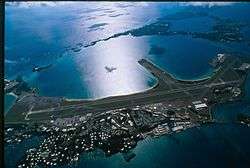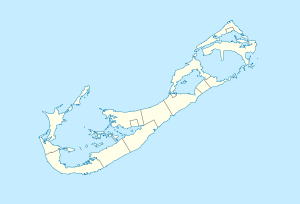L.F. Wade International Airport
| L.F. Wade International Airport | |||||||||||
|---|---|---|---|---|---|---|---|---|---|---|---|
 | |||||||||||
 | |||||||||||
| IATA: BDA – ICAO: TXKF | |||||||||||
| Summary | |||||||||||
| Airport type | Public | ||||||||||
| Owner | Government of Bermuda | ||||||||||
| Operator | Department of Airport Operations, Ministry of Tourism and Transport | ||||||||||
| Serves | Bermuda | ||||||||||
| Location | St. David's Island | ||||||||||
| Elevation AMSL | 18 ft / 5 m | ||||||||||
| Coordinates | 32°21′51″N 064°40′43″W / 32.36417°N 64.67861°WCoordinates: 32°21′51″N 064°40′43″W / 32.36417°N 64.67861°W | ||||||||||
| Website | www.bermudaairport.com | ||||||||||
| Map | |||||||||||
 BDA Location of airport in Bermuda | |||||||||||
| Runways | |||||||||||
| |||||||||||
L.F. Wade International Airport (IATA: BDA, ICAO: TXKF), formerly named Bermuda International Airport, is the sole airport serving the British overseas territory of Bermuda in the North Atlantic Ocean. It is located in the parish of St. George's and is 6 NM (11 km; 6.9 mi) northeast of Bermuda's capital city of Hamilton.[1] In 2006, L.F. Wade International Airport handled about 900,000 passengers, up 7% from 2005.[2] It has one passenger terminal, one cargo terminal, eight aircraft stands and can support all aircraft sizes up to and including the Airbus A380.[3] Currently, seven airlines operate seasonal or year-round scheduled services to Bermuda Airport from Canada, the United Kingdom, and the United States. The largest aircraft now operating in regularly scheduled service at BDA are British Airways' Boeing 777-200s.
History
The airfield began life as Kindley Field, a joint US Army Air Forces (USAAF)/Royal Air Force (RAF) base, during the Second World War. The RAF forces in Bermuda were withdrawn at the end of the War. The local RAF Commander, however, stayed on, on loan to the Bermuda Government, and converted the RAF facilities into the Civil Air Terminal, operated by the local government. When the pre-War airport, a flying boat facility on Darrell's Island, closed in 1948, Bermuda's air routes were taken over by land planes operating through the airfield, which by then was operated by the United States Air Force, as Kindley Air Force Base. In 1970, the field was transferred to the United States Navy, which operated it as US Naval Air Station, Bermuda until 1995 when the US Navy terminated its 99-year lease and the field was transferred to the Bermuda Government, which now operates the airport as part of the Ministry of Tourism & Transport.
The US Navy was not required to meet international civil air standards, despite the operation of civil airlines to the base. The Bermuda Government, however, was required to meet these standards very quickly on assuming control, and at some expense. This involved changes to the airfield lighting, erecting new fences, levelling anything over a certain height and within a certain distance of the runway (including the former base commander's residence, and the hill it stood on), and other changes.
The airport is at the west of St. David's Island, and to the south of Ferry Reach. This places it in the East End of the archipelago, several miles from the current capital, Hamilton.
The airfield was built between 1941 and 1943 by levelling Long Bird Island and several smaller islands, and filling in the waterways between them and St. David's Island. This created a landmass contiguous with St. David's, and the airfield is typically described as being in, or on, St. David's. The field originally had three runways, but only the longest is still in use. Airport map January 1963 One of the others, most of which is on a narrow peninsula jutting into Castle Harbour, has been blocked by munitions bunkers that were built at the harbour end. There are further bunkers on the west side of the peninsula, and the US Navy had referred to the area as the Weapons Pier. Airport workers, today, refer to it as The Finger. The other former runway is today a taxiway to connect aprons one and two to the active runway, and the taxiway which parallels it. This was last used as a runway in 1978. It has its own former taxiway paralleling it, which now serves as a dispersal area for visiting aircraft.
On 16 April 2007 the airport was renamed "L.F. Wade International Airport" in honour of L. Frederick Wade, father of L. Frederick Wade, Jr. L. Frederick Wade was a leader of the incumbent governing party (the Progressive Labour Party) when it was in opposition.[4] The name was criticised by the opposition United Bermuda Party for being politically biased.[5]

Current operations
In 2006, the airport handled almost one million passengers and had 258 airline flight arrivals and departures weekly during the peak June – August summer season. It has received high marks in passenger satisfaction surveys, placing first among North American airports in the "Under 15 million passengers" category in 2003 and fourth worldwide in its size category, according to the global airport monitor report that year.[6] Cited were courtesy of staff, security, and check-in facilities.
The former NATO hangar built in the early 1990s is now used for the airport's growing corporate jet traffic. Because of Bermuda's considerable distance from the nearest land mass, the airport's use by General Aviation aircraft is limited to jets and long-range turboprops. Only jet fuel is available.
The airport offers US Customs and Immigration preclearance, which means US-bound passengers clear Customs in Bermuda; flights arriving in the US from Bermuda are thus treated as domestic flights.
Air traffic control service is provided by BAS-Serco under contract to the DAO. The control tower is located on the north side of the airport (not to be confused with the old tower located at the terminal building) and provides service for most of the day and night. Approach, departure and en route traffic control in the surrounding Oceanic Sector is provided by New York Air Route Traffic Control Center (ZNY), under an agreement between the US Government's Federal Aviation Administration and the United Kingdom. The BDA tower controller and ZNY center controller are always in close contact. Remote radio transmitters and air traffic radar coverage at the airport also link Bermuda and New York Center.
A modern Doppler Weather radar with a 150 mi. range was built by the DAO in 2005. Navaids at the airport, such as the Instrument Landing System (ILS) and VOR (VHF omnidirectional range), are owned by the DAO but maintained by BAS-Serco.
The airport was a United States government NASA Space Shuttle launch abort site.[7] It was only able to be used during low and mid inclination launches.
The airport is also active in affairs of the Airports Council International (ACI), hosting the industry organisation's Legal Affairs Committee annual meeting in 2005.[8] In 2006, ACI selected the airport to host its World Assembly, which was held in Bermuda in November 2010, attended by hundreds of delegates representing airports worldwide.[9] The airport's current general manager is Aaron Adderley.[10]
A small portion of the south-east corner of the airport was transformed in the 1990s into Bermuda Motorsports Park.
Airport agencies
- Department of Airport Operations (DAO) the airport operating authority – part of the Ministry of Tourism & Transport.
- Department of Civil Aviation (DCA) responsible for aircraft registration, safety regulation, and accident investigation – part of the Ministry of Tourism & Transport.
- Bermuda Immigration
- HM Customs
- US Customs and Border Protection, pre-clears passengers on most flights to USA.
- Airport Rescue Firefighting (ARFF), operated by Bermuda Fire Service from 2007
- Bermuda Fire Service, East-end station sits astride perimeter, and provides support to ARFF.
- Airport Security Police, enforces airside regulations and security under contract to the DAO.
- Bermuda Police Service, enforces landside parking and traffic regulations, and holds arrested persons.
- Bermuda Weather Service, operated by Serco under contract to the DAO.
Airlines and destinations
Passenger
| Airlines | Destinations |
|---|---|
| Air Canada | Toronto–Pearson |
| American Airlines | Miami, New York–JFK, Philadelphia, Seasonal: Charlotte, Washington–National |
| British Airways | London–Gatwick |
| Delta Air Lines | Atlanta, Boston, New York–JFK |
| JetBlue Airways | Boston, New York–JFK |
| United Airlines | Seasonal: Newark |
| WestJet | Toronto–Pearson |
Cargo
| Airlines | Destinations |
|---|---|
| Cargojet Airways | Newark |
Accidents and incidents
- On 6 December 1952 A Cubana de Aviación DC-4 crashed after taking off from the airport killing 37 passengers out of 41 passengers and crew.[11]
- On October 27, 1962, a U.S. Air Force Boeing RB-47 Stratojet crashed on takeoff, killing all four crew members on board.[12]
See also
- Royal Air Force, Bermuda (1939–45)
- Hurricane Fabian
- Hurricane Igor
- Transport in Bermuda
- The Causeway, Bermuda
- Hurricane Gonzalo
References
- 1 2 Bermudan AIP
- ↑ Bermuda's L. F. Wade International Airport (information page maintained by The Royal Gazette)
- ↑ "Airport Information". L.F. Wade International Airport. Retrieved 10 September 2015.
- ↑ Glenn Jones (17 April 2007). "Airport formally renamed". The Royal Gazette. Retrieved 27 September 2007.
- ↑ Amanda Dale (16 April 2007). "Govt. accused of bias over naming public places after national heroes". The Royal Gazette. Retrieved 27 September 2007.
- ↑ Hill, René (1 July 2003). "Bermuda's airport gets high rating – again". The Royal Gazette. Retrieved 22 May 2009.
- ↑ "Space Shuttle Emergency Landing Sites". GlobalSecurity.org. Retrieved 12 March 2008.
- ↑ "Island to host prestigious aviation conference". The Royal Gazette. 31 May 2004. Retrieved 22 May 2009.
- ↑ Neil, Scott (17 November 2006). "Dr. Brown: Tourism critics are way off the mark". The Royal Gazette. Retrieved 22 May 2009.
- ↑ "Airport Operations". Government of Bermuda. Retrieved 18 July 2014.
- ↑ Harro Ranter (6 December 1952). "ASN Aircraft accident Douglas DC-4 CU-T397 Bermuda-Kindley Field (BDA)".
- ↑ http://b-47.com/wp-content/uploads/2014/03/Boeing-B-47-Losses-and-Ejections.pdf
External links
- Bermuda International Airport, official site
- Bermuda Online: American military bases in Bermuda 1941 to 1995.
- Bermuda International Airport weather radar – real-time display